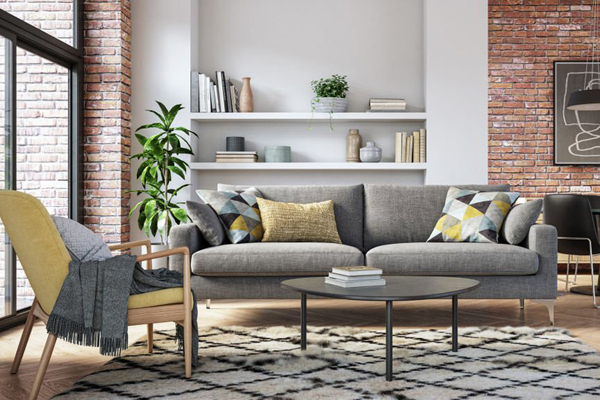Prime
The efforts to preserve African designs in global architecture

African designs are sustainable, simple and are in harmony with nature,. PHOTOs/www.gettyimages.com
What you need to know:
We need to patent the unique Afro-chic designs for sustainability. Our designs are being stolen across the world; many young designers do not know that their designs have to be patented.
Interior designers play a pivotal role in beautifying our living and working spaces; but this trade is faced with a number challenges in Africa that range from the theft of African designs, ignorance of the existence of chic African designs, to lack of teaching African designs in professional training institutions, among others. African designs are sustainable, simple and are in harmony with nature, the principal architect and managing director, S. Tetteh and Associates, Architects in Accra, Ghana, Senyo Tetteh says.
“Afro-Chic architecture is the African style of architecture rich in patterns, indigenous African building technology, earthy colours, beads, vivid hues, patterns, bronze and brass sculptured tribal symbols, straw, decorated calabashes, African printed textiles and wooden masks to name a few. Full of vibrant colours and textured elements, the theme seeks to evoke a sense of artistic afro-centric vibe,” Tetteh explains.
Asked to describe the current trends of decor, interior design, Tetteh says: “Design has become more intentional in Africa. The use of earth colours, sculptures and paintings by Africans and the development of materials that respond to our climatic conditions here in Africa making it more sustainable.”
Who determines trends?
The principal architect at Dream Architects based in Kampala, Patricia Khayongo Rutiba, notes that In West and South Africa, many buildings are going up that depict African concepts and themes and this influences the look of the buildings and goes right into the interior to influence finishing materials as well as decor.
“In East Africa, our big projects are still looking either European or Chinese and at an individual level, pintrest buildings are the rage,” she comments about the current trends of decor, interior design, and architecture in Uganda and Africa at large.
Speaking at the conversation “Afro-chic – Decor, Interior Design, and Architecture” at the continents’ largest gathering of creatives known as the Creative Africa Nexus (CANEX) at the second Intra Africa Trade Fair (IATF 2021) held from November 15-21 in Durban, South Africa, the founder and creative director of Africa By Design and AMWA Designs (Ghana and United Kingdom), Chrissa Amuah observed: “People do not know that chic African designs exist. People have a mentality that the best designs are from the West.”
“We need to patent the unique Afro-chic designs for sustainability. Our designs are being stolen across the world; many young designers do not know that their designs have to be patented,” Tetteh urges.
Rutiba, notes that we can incorporate our African heritage of storytelling in our designs by getting the general public and the developers to appreciate their continent and countries because they determine the aesthetic since they pay for the building projects.
“We also need some bold developers who are willing to experiment and allow the architects to go all out in design inspired by African concepts so that when they do something that stands out, they will then start setting a new trend,” she adds.
As to what we have maintained from the mighty ancient Egypt and its magnificent pyramids, Tetteh, notes that, “Mostly the form of the pyramid has been mimicked and destructed in modern architecture buildings.”
The value of cultural designs
“Many of the items that inspire or that are referenced in contemporary African design were traditionally used for cultural purposes and held ceremonial significance. Their creation has never been inspired by financial gain. As a continent, Africa has never put a commercial value to its designs, hence why as a sector it is less developed than more formal sectors, such as law or medicine,” Amuah says.
“The youth are encouraged to get into the music industry because of the successful wealthy music stars. We need to expose them to alternative professions such as design while still in school,” the design director at Broad Based Design and Umongo in South Africa, Mlondolozi Hempe, notes.
While Tetteh says design competitions are important because they come with financial rewards and publicity, Amuah defers, arguing that one should not be incentivised by financial rewards, but rather by long term gains. There are things I have done in design and I have not got financial gains.
“Machines are dominant now and we are losing skilled personnel in the process in Africa. Therefore, we need collaborations across the African continent,” Hempe says.
“The Internet is now enabling us to tell our stories and sell online. The future is going to be bright,” Tetteh said.
Tettah, Hempe and Amuah were part of the panel made up of Pan-African experts who discussed how Africa is inspiring trends in design and décor at the CANEX. Tetteh believes that events such as the IATF/CANEX are very important for artistic collaborations and training.
“They can enable us as artists to start collaborations and training. We should create centres of excellence for architecture in terms of what Afro-chic is including education trips and tours,” he says.
“The difference between art and design is that design serves to be both beautiful, whilst also functional. The continent has a deep rooted culture of up-cycling and repurposing materials. This sort of design practice is something to be revered and elevated,”Amuah suggests.
“One should own a house that is in harmony with the landscape, paintings on the wall telling stories, and a kitchen with a space for dining. One needs a house with many functions. It should have close ventilation, and large windows for fresh air and in that case you do not need air conditioning,” Tetteh says. “In school we are never taught what African design is,” Hempe notes.
Asked if Africa has enough professionals on the continent to drive this sector forward, Tetteh says: “The continents professional scene is growing steadily. We have more architects today than we had a century ago. This is an exciting time to explore our talents and creative sides to solve challenges within the country.”
The future
While she notes that there are more professionals she decries the discrimination locals face when it comes to the projects that make a difference. Rutiba says: “Actually the biggest challenge we have is that a lot of large projects go to foreign firms and there are no contract clauses to enforce two-way knowledge transfer by collaboration between local architects and foreign ones. That means many years later, we may still not have the capacity to handle huge projects and we will keep bringing in foreign architects while the local ones languish without work.”
Rutiba says the future of this industry is bright because we are an emerging continent with the youngest population. “Our generation just needs to insist that our development partners include better working and remuneration terms for them as opposed to burdening them with huge debts and unfair global trade and work conditions,” Rutiba says.
The history and origins of interior design
“Interior design is defined as the art and science of enhancing the interior of a space in order to create a polished and more aesthetically pleasing environment. An interior designer is someone trained to execute plans, research, coordinate, and manage decorative projects with authority. The profession of interior design is varied and includes space planning, conceptual development, site inspections, programming, research, communicating with the clients, project and construction management, and of course the execution of the desired design,” according to tradeforum.org.
Before the profession rose to prominence, interior design came in instinctively to strictly coordinate with the architecture of buildings. The profession of interior design came with the rise of middle-class society and the complicated architecture that rose to popularity during the industrial revolution. The quest to make the best use of space, along with the attention to user well-being and functional design continues to push the development and life-enhancing possibilities of today’s iteration on the interior design profession, says radeforum.org.
That said, the profession of interior design is distinctly separate from the work of an interior decorator, a moniker more commonly used across the US. The term interior decorator is less commonly used in the UK where the profession of interior design remains unregulated and sadly, not yet considered an official profession to this day, radeforum.org adds.
“The practice of interior design harkens back to the Ancient Egyptians, who decorated their mud homes with basic furnishings enhanced by animal skins, simple textiles, graphic biographical and spiritual murals, sculptures, and painted urns. Ornate gold ornaments found in Egyptian tombs (such as King Tutankhamen’s) and trinkets highlighted the need for more distinctively rich decoration to symbolise the more wealthier and powerful Egyptians,” radeforum.org says.
According to radeforum.org, Roman and Greek civilizations advanced the Egyptian art of interior designing and accessorizing by celebrating civic pride through their invention of domed-roof public buildings. For their homes, elaborate Greek wooden furniture featured intricate ivory and silver decoration while the Romans concentrated on marrying beauty and comfort, with both civilisations home interiors designed to reflect wealth and social and political status. Roman furniture was often made of stone, marble, wood, or bronze, and was made comfortable via cushions and expressive tapestries. To elevate their homes, both Romans and Greeks brought in vases and created mesmerising mosaic floors, and wall paintings and frescoes to make their spaces unique to them.




